 |
Albert Peter Low
was an important figure among the Canadian explorers
who helped map the vast spaces that had been added to
Canada's frontiers after Confederation. At one point, he was
director of the Geological Survey of Canada.
In 1903, he was appointed to command the sealing steamship
Neptune for an expedition to the Arctic with the aim of
establishing Canada's sovereignty on Southampton, Ellesmere and
adjacent islands.* The Neptune wintered over in Fullerton
Harbour, near Captain Comer's Era. During the winter of
1903–1904, Low acquired a collection of ivories, very similar to those
of Captain Comer's, now also in the CMC collection. They were given by
Estelle Low, A. P. Low's daughter, to the Public Archives of Canada,
which transferred them to the CMC in 1962.**
*Low, A. P.
1906 – The Cruise of the Neptune. Report on the Dominion
Government Expedition to Hudson Bay and the Arctic Islands 1903-1904.
Ottawa: Government Printing Bureau.
**von Finckenstein, Maria
1999 – "A Few Things in the Way of Curios: Historic Ivories
at the Canadian Museum of Civilization." Inuit Art Quarterly
14(4):28-32.

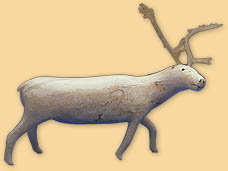 |
Caribou, 1903–1904
Fullerton Harbour, West Coast of Hudson Bay, Nunavut
Ivory, musk-ox horn, black colouring
8.5 x 10.5 x 3 cm
CMC IV-B-799
Collected by A. P. Low during the Neptune expedition of 1903–1904
|
 |
Most ivories in A. P. Low's collection can be safely attributed to
Harry Teseuke, Captain Comer's mate, who was chief of the Aivilingmiut.
This elegant caribou, with delicate legs barely supporting the body,
reveals Harry's extraordinary talent.
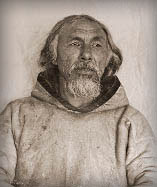
|
"Harry, Chief of
the Aivilingmiut"
Photo: A. P. Low
©CMC Archives neg.# 2796
(Photo Cd: CD 95-807-028)
|
Exhibition History:
Iqqaipaa: Celebrating Inuit Art, 1948–1970. Canadian Museum of
Civilization, Hull, Quebec, April 1, 1999 – February 6, 2000; Eiteljorg
Museum of American Indians and Western Art, Indianapolis, U.S.A,,
June 9 – September 30, 2001.
In the Shadow of the Sun: Perspectives on Contemporary Native Art.
Museum am Ostwall fuer Kunst und Kulturgeschichte, Dortmund,
Germany, December 9, 1988 – February 27, 1989; Canadian Museum of
Civilization, Hull, Quebec, June 29, 1989 – January 2, 1990; Art Gallery
of Nova Scotia, Halifax, Nova Scotia, April 20 – June 24, 1990;
Rijksmuseum Voor Volkenkunde, Leiden, Netherlands, August 30 – October
18, 1991. Exhibition catalogues in German and English.
References:
Hoffman, Gerhard (ed.)
1988 – Im Schatten der Sonne: Zeitgenoessische Kunst der
Indianer und Eskimos in Kanada. Exhibition ca-talogue. Stuttgart:
Edition Cantz, no. 130, p. 442.
von Finckenstein (ed.)
1999 – Celebrating Inuit Art: 1948–1970. Hull, Quebec:
Canadian Museum of Civilization, and Toronto: Key Porter Books,
ill. p. 53.
von Finckenstein, Maria
1999 – "A Few Things in the Way of Curios: Historic Ivories
at the Canadian Museum of Civilization." Inuit Art
Quarterly 14(4): ill. p. 28.
von Finckenstein, Maria
2002 – "Harry Teseuke, Captain Comer's Mate: Historic Ivories
at the Canadian Museum of Civilization, part II." Inuit
Art Quarterly 17(4): pp. 42-45.
Standing Hunter with Harpoon, 1903–1904
Fullerton Harbour, West Coast of Hudson Bay, Nunavut
Ivory, black colouring
7.5 x 6 x 2.5 cm
harpoon: 6.3 cm long
CMC IV-B-782
Collected by A. P. Low during the Neptune expedition of 1903–1904
|
|
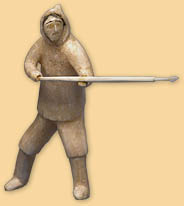 |
 |
This portrait of a hunter about to throw a harpoon catches the
figure in motion – very unusual for ivories from this period. It is
part of a group of hunters pursuing various activities, which was
found in A. P. Low's collection.
Reference:
von Finckenstein, Maria
1999 "A Few Things in the Way of Curios: Historic Ivories at
the Canadian Museum of Civilization." Inuit Art
Quarterly 14(4): ill. p. 30.
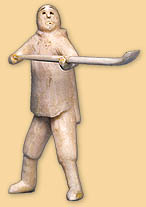 |
Standing Man with Ice-Scoop, 1903–1904
Fullerton Harbour, West Coast of Hudson Bay, Nunavut
Ivory, black colouring
5 x 4.5 x 1.2 cm
CMC IV-B-774
Collected by A. P. Low during the Neptune expedition of 1903–1904
|
 |
Stylistic similarities point to the fact that this figure was done
by the same artist as "Standing Hunter with Harpoon." In
both sculptures there is an attempt to show movement; here the handling
of the ice-scoop requires a complicated turning of the upper torso and
face. This hunter is engaged in scooping the ice out of a seal's
breathing hole. von Finckenstein, Maria
1999 "A Few Things in the Way of Curios: Historic Ivories at
the Canadian Museum of Civilization." Inuit Art
Quarterly 14(4): ill. p. 30.
Standing Hunter with Rifle, 1903–1904
Fullerton Harbour, West Coast of Hudson Bay, Nunavut
Ivory, black colouring
7 x 5.5 x 2 cm
rifle:
CMC IV-B-781
Collected by A. P. Low during the Neptune expedition of 1903–1904
|
|
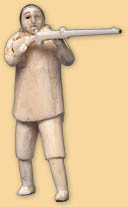 |
 |
The artist has captured the moment when the hunter is shouldering
his rifle, just before taking aim. The figure is perfectly balanced,
capable of standing on its own, without support. While the clothing is
stylized, careful attention has been given to the facial features.
Exhibition History:
Arctic Mirror. Canadian Museum of Civilization, Hull, Quebec,
January 25 – September 9, 1990. No catalogue.
Sculpture/Inuit: Masterworks of the Canadian Arctic.
Organized by the Canadian Eskimo Arts Council. Vancouver Art Gallery,
Vancouver, B.C., November 9 – December 9, 1971; Le Grand Palais, Paris,
France, February 10 – April 2, 1972; Nationalmuseet, Copenhagen, Denmark,
April 26 – May 28, 1972; The Hermitage, Leningrad, Russia, June 29 –
July 23, 1972; Pushkin Fine Arts Museum, Moscow, Russia, August 10 –
September 10, 1972; Burlington Gardens Museum, London, England,
October 5 – December 10, 1972; Philadelphia Museum of Art,
Philadelphia, U.S., January 24 – March 4, 1973; National Gallery of
Canada, Ottawa, May 17 – June 17, 1973.
References:
Canadian Eskimo Arts Council
1971 – Sculpture/Inuit. Exhibition Catalogue. Ottawa:
Canadian Eskimo Arts Council, no. 94.
Hoffman, Gerhard (ed.)
1988 – Im Schatten der Sonne: Zeitgenoessische Kunst der
Indianer und Eskimos in Kanada. Exhibition catalogue. Stuttgart:
Edition Cantz, p. 223.
von Finckenstein, Maria
1999 – "A Few Things in the Way of Curios: Historic Ivories
at the Canadian Museum of Civilization." Inuit Art
Quarterly 14(4): ill. p. 29.
|